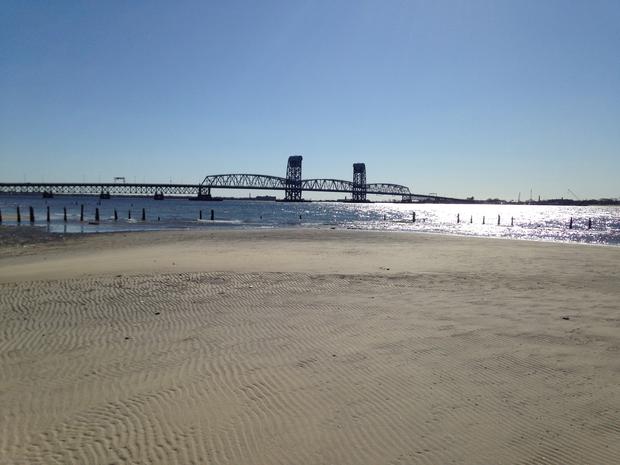
When Sandy hit more than two years ago, most of the hundreds of thousands of people who live on the shores of Jamaica Bay were not expecting to get wet. The bay was protected from the Atlantic Ocean by the Rockaway Peninsula, after all, and many areas were not even ordered to evacuate.
Yet the water pushed into the bay and up onto the shore, crossing several acres of parkland at points to cause extensive flooding in neighborhoods in southern Brooklyn and Queens.
“It was crazy to see the water come here,” said Anna Felicia, a resident of Bergen Beach who estimated the water was three or four feet deep after the storm. “A lot of people were running, out of their houses, the way it was coming so fast.”
Since Sandy, the Army Corps has been studying how to prevent nature from striking again in what could turn out to be the most expensive flood-control project in the region. According to a preview provided to WNYC, the Corps has focused on two possible strategies: a giant gate spanning the entrance to the bay, or a series of levees, grassy berms and sea walls that would protect the interior perimeter of the bay.
“Both would be effective,” said Dan Falt, the Army Corps’ project manager in charge of the plan. “Both would take a long time to build. We are trying to determine right now the environmental impacts of both and that may be how we differentiate these things.”
Each approach would cost roughly the same – $2 billion to $4 billion. Either is about a decade away from completion, Falt said. The plan itself dates back to 2003, but has been delayed several times, because of lack of funding. The Corps, under pressure from lawmakers, will present details of both a plan for the bay as well as one for the Atlantic side of the Rockaway peninsula at a community meeting April 22.
The idea of a gate, or storm surge barrier, first came up with half a century ago, when the Army Corps first understood how vulnerable bayside communities were. Similar gates have been constructed in the Netherlands and London – and one has been imagined to span lower New York Harbor to protect Manhattan and other points.
The Jamaica Bay model would not be as large, but would be sizable: more than a mile across if it reached from Breezy Point on the Rockaways to Manhattan Beach. That location was proposed by the city two years ago, and is favored by the Corps because it would protect a stretch of densely populated Brooklyn. (The 1964 Army Corps plan placed the gate further east, under the Marine Parkway-Gil Hodges Bridge.)
The barrier would stay open most of the time and then close, like saloon doors, when a hurricane approached. But even when open, the machinery along the sides of the inlet might impede the circulation of water into and out of the bay, worsening the water quality.
“For me, the problem with the gates is that you are creating a closure in an ecology and in a system,” said Catherine Seavitt, a landscape architect and associate professor at City College who has been studying coastal protection. “What we’ve been looking at with our study of Jamaica Bay is how can you get more exchange of waters in Jamaica Bay, how can you bring more ocean-to-bay transfer, which brings sediment with it, and that sediment nourishes the marshes.”
By contrast, the perimeter plan would allow water to circulate more freely into and out of the bay, and block surges just before they slosh up into people’s homes. But the perimiter plan would place levees and berms on present-day wetlands, and also raise questions about how to best protect Kennedy Airport, located on the eastern end of the bay.
“I don’t know if you want to build tall walls near airports,” Falt said. “So there may be increased benefits from a hurricane barrier.”
After getting feedback from the public, Falt said it would come up with a proposal later this year. The funding, though, presents another hurdle: The roughly $4 billion that the Army Corps received from the federal Sandy aid bill will cover the cost of fortifying the Rockaways, but is not expected to fully fund the bayside protections. The city, state and the federal governments would likely need to contribute additional funds.

